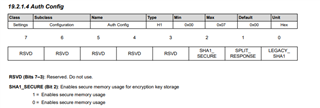Other Parts Discussed in Thread: BQKEYPACKAGER, BQKEYPROGRAMMER
Tool/software:
Hi Everyone
I am trying to do SHA1 authentication on BQ40Z80, but I have some questions about the SHA1_SECURE bit.
In the Technical Reference Manual, it is stated that ‘Enables secure memory usage’ for SHA1_SECURE bit when it is both 0 and 1. However, when I set this bit to 1, I cannot authenticate. When I try to change the key, it gives the message that the key was successfully changed, but when I try to authenticate with the new key, I cannot succeed again.
When I set it to 0, I have no problem in both changing the key and authenticating.
In this case, what is the difference whether the SHA1_SECURE bit is 0 or 1? Also, why can't I authenticate when I set it to 1?
I have attached screen excerpts showing SHA1_SECURE bit and authentication error.
Thank you for your help.



